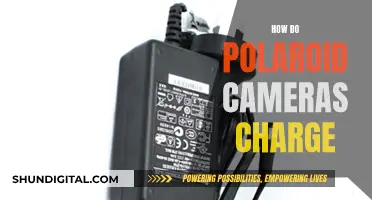
Camera equipment can be expensive and delicate, and carrying it on an airplane can be a daunting task. One of the most important considerations when travelling with camera gear is ensuring that batteries are transported safely and in compliance with airline regulations. This is particularly important with lithium-ion batteries, which are now commonplace in cameras and other electronic devices.
| Characteristics | Values |
|---|---|
| Battery type | Dry cell alkaline batteries, dry cell rechargeable batteries, lithium-ion batteries, lithium metal batteries |
| Battery size | AA, AAA, C, D, 9-volt, button-sized cells, etc. |
| Lithium-ion battery allowance | Up to 2 large lithium-ion batteries (101-150Wh) and an unlimited number of batteries (100Wh) |
| Battery placement | Carry-on baggage |
| Battery protection | Tape across battery contacts to isolate terminals, place each battery in its own protective case/plastic bag |
| Battery chargers | Allowed in carry-on and checked bags |
| Prohibited batteries | Car batteries, wet batteries, spillable batteries (unless for a scooter/wheelchair) |
What You'll Learn

Keep batteries in hand luggage
Keeping batteries in your hand luggage is the best way to ensure they are transported safely and securely. Most airlines and airports recommend this, and it is often a requirement.
Firstly, it is important to know that the rules for transporting batteries vary depending on the type of battery and the airline you are flying with. It is always best to check with your airline before travelling.
Dry cell alkaline batteries (AA, AAA, C, D, 9-volt, etc.) are typically allowed in hand luggage with no restrictions on quantity. You can also pack rechargeable dry cell batteries, such as Nickel Metal Hydride (NiMH) and Nickel Cadmium (NiCad), in your carry-on.
Lithium-ion batteries are where things get a little more complicated. These are often found in cameras, laptops, cell phones, and other small electronic devices. Most lithium-ion batteries are under 100 Watt hours (Wh) and can be packed in carry-on luggage, as long as they are protected from damage and short circuits. It is recommended that you tape over the battery contacts to avoid short-circuiting. If you are travelling with lithium-ion batteries installed in devices, it is best to keep the devices in your carry-on luggage, with the devices switched off, not in sleep mode.
Lithium-ion batteries with more than 100Wh are subject to more restrictions. You will usually need prior approval from your airline to pack these in your carry-on, and only two spares are typically allowed.
Lithium metal batteries, often used in cameras and other small personal electronics, are non-rechargeable and are permitted in carry-on bags, as long as they contain 2 grams or less of lithium per battery.
Other types of batteries, such as non-spillable wet batteries and spillable batteries, have varying rules and restrictions, so it is important to check before travelling.
In general, it is recommended to keep batteries in their original packaging or a protective case, such as a plastic bag, to avoid accidental activation during the flight. It is also a good idea to label the batteries and ensure the battery compartment of any devices is secured.
By keeping your batteries in your hand luggage, you can ensure they are easily accessible and monitored during the flight, reducing the risk of fire or damage.
Charging Your Sanyo E1090: Quick and Easy Guide
You may want to see also

Tape battery contacts
When flying with camera equipment, it is important to take precautions to ensure the safety of your equipment and compliance with airline regulations. This includes properly packaging and taping your camera batteries. Here are some detailed instructions on how to tape battery contacts when travelling by plane:
Before placing your batteries in your carry-on luggage, it is important to take note of the type of batteries you are carrying. Most camera batteries are lithium-ion batteries, which are allowed in carry-on bags. However, it is recommended to check the specific regulations of your airline, as there may be restrictions on the number and size of lithium-ion batteries allowed.
To tape your battery contacts, start by inspecting the battery terminals. Ensure that all the metal parts are exposed and accessible. Take a piece of electrical tape, preferably yellow, and cut it to an appropriate length. Yellow electrical tape is recommended as it is visible and indicates that you have taken the necessary precautions. Cover the battery terminals with the tape, ensuring that all metal parts are enclosed. You can also use painter's tape, as it is a good insulator and leaves no residue. Alternatively, gaffers tape is an option that provides a strong hold without leaving any residue.
When taping the battery contacts, make sure the tape is secure and will not come off easily. This will help prevent short-circuiting and potential hazards during your flight. It is also a good idea to place each battery in its own protective case, plastic bag, or package. This adds an extra layer of protection and isolates the terminals.
By following these steps, you can help ensure the safe transportation of your camera batteries on an airplane. Remember to dispose of used batteries properly and to keep them away from heat sources and children. Additionally, always refer to the specific guidelines provided by your airline and the Transportation Security Administration (TSA) for the most up-to-date information on battery safety and regulations.
London Congestion Charge Cameras: Locations and How They Work
You may want to see also

Use carry-on bag within airline limitations
When travelling with camera equipment, it is important to keep your gear safe, legal, and within airline limitations. To do this, you should consider using a carry-on bag.
Firstly, it is important to choose a carry-on bag that fits within airline limitations. The Pelican 1510, for example, is a hard case that is the correct carry-on size and allows you to keep your camera and necessary batteries together. Most airlines allow carry-on luggage with dimensions of 22 x 14 x 9 inches (56 x 36 x 23 cm), but it is important to check the specific limitations of your airline. Your carry-on bag must fit in the overhead bin or under the seat in front of you. If it doesn't fit, you may need to check it in.
In addition to your carry-on bag, you are usually allowed to bring one personal item, such as a purse or small handbag, which must fit under the seat in front of you. The dimensions of this item should not exceed 18 x 14 x 8 inches (45 x 35 x 20 cm).
When packing your camera equipment, it is important to consider the weight limitations of your airline. Most domestic airlines do not have a weight limit for carry-on bags, but several international airlines do. To avoid excess baggage fees, you can keep some smaller camera equipment, such as lenses and batteries, in your jacket pockets, as items on your person are not weighed.
When packing camera batteries, there are a few safety guidelines you should follow. Tape up the metal contacts on all your batteries to prevent short-circuiting, and do not pack damaged batteries. Lithium-ion batteries, such as those used in cameras, are allowed in carry-on bags but must not exceed a certain wattage. You are allowed to fly with two large lithium-ion batteries between 101 and 150 Wh, and an unlimited number of batteries under 100 Wh, as long as they are not for resale.
By following these guidelines, you can ensure that your camera equipment is safely and securely transported within the limitations set by airlines.
Charging Your Roku Doorbell Camera: A Step-by-Step Guide
You may want to see also

Weight limits and excess baggage
When flying with camera equipment, it's important to be aware of weight limits and excess baggage regulations to avoid additional costs. Here are some key points to consider:
Weight Limits for Carry-On Baggage:
Most domestic airlines in the US do not enforce a weight limit for carry-on bags. However, several international airlines have weight restrictions, which vary depending on the airline and your destination. It's crucial to check the specific regulations of your chosen airline. As a general guideline, a carry-on bag should be light enough to lift into the overhead bin.
Weight Limits for Different Airlines:
- American Airlines: Carry-on bags may weigh up to 40 pounds.
- Allegiant Air: No maximum weight if you pay for carry-on luggage.
- Delta Airlines: No weight limit for domestic flights.
- Frontier Airlines: Carry-on weight limit of 35 pounds.
- Hawaiian Airlines: Weight limit of 25 pounds for carry-on bags.
- JetBlue Airlines: No maximum weight, but the lowest-cost basic airfare does not include a carry-on bag.
- Southwest Airlines: No weight limit specified.
- Spirit Airlines: 40-pound weight limit, but basic airfare only includes a personal item.
- United Airlines: Carry-on bags may weigh up to 50 pounds, but basic airfare only includes a personal item.
Excess Baggage:
Excess baggage fees can be expensive, and it is usually more cost-effective to book and pay for excess baggage in advance rather than at the airport. To avoid excess baggage fees, consider the following tips:
- Choose a lightweight carry-on bag: Opt for a bag that is designed to be lightweight, making it easier to stay within the weight limit.
- Distribute weight wisely: Keep some camera equipment, such as lenses and batteries, in your jacket pockets. Items on your person are not weighed, so this can help keep your carry-on bag within the weight limit.
- Utilize multiple bags: Most airlines allow you to carry a laptop or small bag in addition to your main carry-on. Distribute your equipment across these bags to reduce the weight in any single bag.
- Book excess baggage in advance: If you anticipate needing excess baggage, book it ahead of time to take advantage of lower rates.
Remember to always check the latest regulations and guidelines provided by your chosen airline, as weight limits and excess baggage policies can vary.
How to Prepare Your Polaroid Camera for Instant Shots
You may want to see also

Packing camera equipment in the hold
When packing camera equipment in the hold, it is important to take precautions to ensure your gear stays safe and secure. Here are some detailed instructions to follow:
- Use a hard-sided case: Invest in a high-quality, hard-sided case like the Pelican 1510, which can withstand impacts and protect your equipment from damage.
- Pad and secure your equipment: Place padding or cushioning inside your case to protect your camera gear from bumps and shifts during the flight. Ensure that all items are tightly secured and won't shift around.
- Remove batteries and memory cards: Take out all batteries and memory cards from your cameras and store them separately in your carry-on luggage. This is a safety precaution to prevent overheating and also allows you to utilise the limited space in your hold luggage for other gear.
- Pack delicate items separately: Detach lenses from camera bodies and pack them separately in their own padded cases or wraps. This will prevent stress or damage to the threads that hold the lens to the camera.
- Label and insure your equipment: Clearly label your case with your contact information and consider insuring your camera equipment before your trip. This will give you peace of mind in case of loss or damage.
- Inform the airline: Notify the airline staff that you are checking in valuable camera equipment. This will help them handle your luggage with extra care and ensure it is stored securely.
- Be mindful of weight restrictions: Check the weight restrictions for hold luggage with your airline and distribute the weight of your camera gear across multiple bags if necessary. Excess baggage can be expensive, so plan accordingly.
- Consider a carry-on for essential items: While packing your hold luggage, keep in mind that you can also bring a carry-on bag and a personal item (like a backpack) on the plane. Use these to carry essential camera gear that you want to keep close at hand, such as your main camera body, lenses, and other valuable items.
Remember to always check the latest regulations and guidelines provided by your airline and local aviation authorities when packing camera equipment in the hold.
Vicohome Camera Charging: A Step-by-Step Guide
You may want to see also
Frequently asked questions
You can carry standard AA, AAA, C, and D batteries with no restrictions. You can also carry lithium-ion batteries, but there are some restrictions.
Lithium-ion batteries must be under 100 watt-hours (Wh) to be carried on a plane. You can carry as many of these as you like, but they must be in your carry-on luggage. You can also carry up to two larger lithium-ion batteries that are between 100 and 160 Wh.
No, spare uninstalled lithium batteries are prohibited in checked luggage. If you pack camera batteries in your checked luggage, they will likely be confiscated by the TSA for safety reasons.
It is recommended to place each battery in its own protective case, plastic bag, or package. You should also tape over the battery's contacts to isolate the terminals and prevent hazards due to short-circuiting.
Yes, it is generally recommended to pack valuable camera equipment, including batteries, in your carry-on luggage to reduce the risk of theft or damage.







